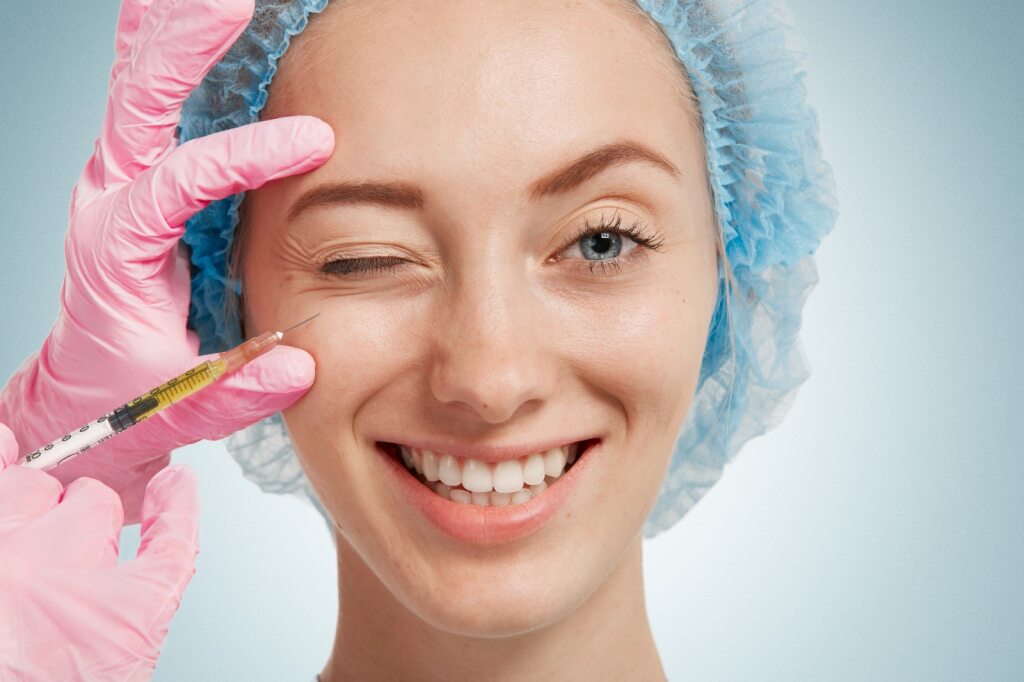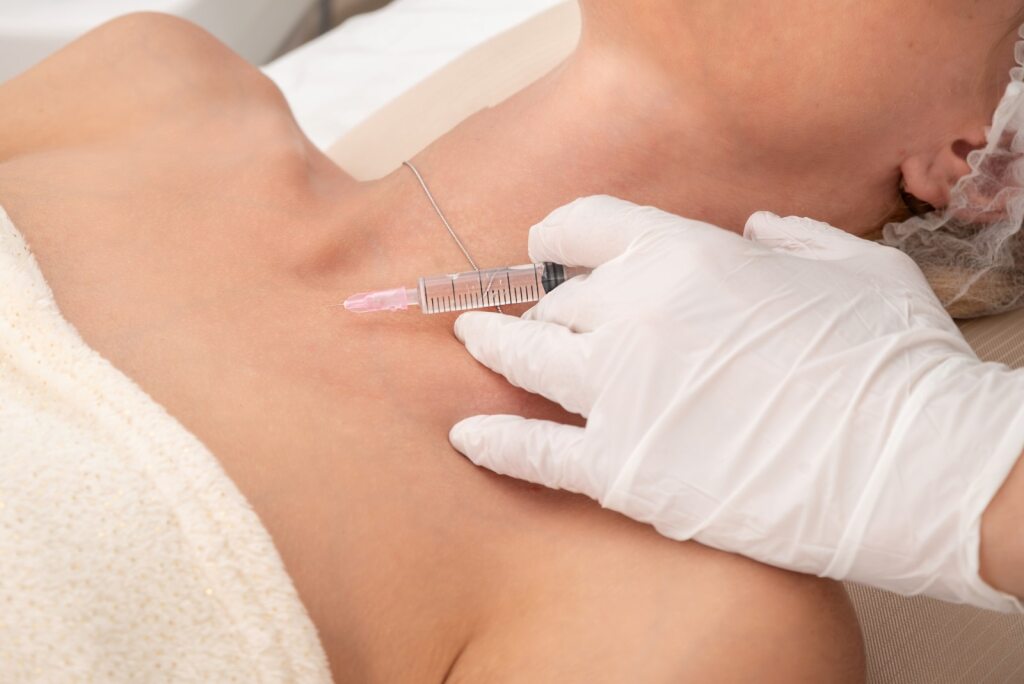Biorevitalisaatio ja mesoterapia

Mikä on biorevitalisaatio?
Biorevitalisaatio on yksi suosituimmista esteettisistä hoidoista nykykosmetologiassa. Kyseinen menetelmä palauttaa ihon luonnollisen hehkun ja kimmoisuuden ilman kirurgisia toimenpiteitä tai pitkiä toipumisaikoja.
Biorevitalisaatio on hoito, jossa ihoon injektoidaan hyaluronihappoa – tarkemmin sanottuna sen pienimolekyylisiä muotoja, jotka pääsevät vaikuttamaan syvälle dermikseen. Hyaluronihappo kosteuttaa ihoa, stimuloi sen uusiutumista ja tekee ihosta sileämmän, heleämmän ja elinvoimaisemman.
Iän myötä ihon luonnollinen hyaluronihappopitoisuus vähenee, mikä johtaa kosteuden haihtumiseen ja ihon kuivumiseen. Biorevitalisaatio kompensoi tätä prosessia tarjoamalla syväkosteutusta ja palauttamalla iholle terveen ja raikkaan ilmeen.

Mikä on mesoterapia?
Mesoterapia on injektiohoito, jossa ihoon viedään yksilöllisesti räätälöityjä ravintoainecocktaileja, kuten vitamiineja, aminohappoja, peptidejä, hivenaineita sekä muita aktiivisia aineita. Hoidon tavoitteena on ravita ihoa, parantaa mikroverenkiertoa ja aktivoida aineenvaihduntaa ihon syvemmissä kerroksissa.
Toisin kuin biorevitalisaatio, joka keskittyy ensisijaisesti kosteutukseen, mesoterapia toimii ihon "vitamiinibuustina", erityisesti silloin, kun iho on väsynyt, eloton, stressaantunut tai altistunut ulkoisille ärsykkeille.
Mitä hyötyä mesoterapiasta on?
- Parantaa ihon sävyä
- Vähentää turvotusta ja tummia silmänalusia
- Tasoittaa ihon pintaa
- Hoitaa aknea ja aknearpia
- Aktivoi solujen aineenvaihduntaa
- Ravitsee ihoa tärkeillä aktiiviaineilla
Biorevitalisaation ja mesoterapian hoitoalueet
Biorevitalisaatio sopii kasvojen ja vartalon alueille, joissa iho on altis ikääntymiselle, kuivumiselle tai kimmoisuuden heikkenemiselle. Hoitoja voidaan tehdä mm.:
- Kasvot: erityisesti silmänympärykset (”harakanvarpaat”), nasolabiaalijuonteet, otsa ja posket
- Kaula ja dekoltee: usein unohdettuja, mutta helposti ikääntyviä alueita
- Kädet: käsien iho ohenee nopeasti – hoito palauttaa kosteutta ja kimmoisuutta
- Polvet, kyynärpäät ja selkä: kosteutuksen ja ihon rakenteen parantamisen tueksi
Mitä biorevitalisaatioaineet sisältävät?
Biorevitalisaation pääasiallinen vaikuttava aine on hyaluronihappo. Se vastaa ihon kosteutuksesta sekä sen kimmoisuuden ja elastisuuden säilyttämisestä. Biorevitalisaatiohoidoissa käytetään pienimolekyylistä hyaluronihappoa, joka kykenee tunkeutumaan ihon syvempiin kerroksiin ja vaikuttamaan suoraan solutasolla.
Hyaluroonihapon lisäksi valmisteet voivat sisältää myös muita aktiiviaineita, kuten:
- Peptidejä, jotka stimuloivat kollageenin ja elastiinin tuotantoa sekä parantavat ihon rakennetta
- Antioksidantteja, jotka hidastavat ihon ikääntymisprosesseja
- Vitamiineja (A, C, E, B-ryhmä), jotka ravitsevat ihoa ja suojaavat sitä ulkoisilta rasituksilta
- Koentsyymi Q10:tä ja DMAE:ta, jotka antavat soluille energiaa uudistumiseen
- Aminohappoja ja hivenaineita, jotka tukevat solujen uusiutumista ja ihon aineenvaihduntaa
Kaikkien näiden aineiden yhteisvaikutuksena iho muuttuu kimmoisammaksi, sileämmäksi ja heleämmäksi.
Mitä eroa on biorevitalisaatiolla, täyteaineilla ja mesoterapialla?
Biorevitalisaatio, mesoterapia ja täyteainehoidot sekoitetaan usein keskenään, mutta jokaisella niistä on oma tarkoituksensa.
- Biorevitalisaatio keskittyy ihon kosteuttamiseen ja palauttamiseen. Hoito parantaa ihon laatua, palauttaa kosteustasapainoa sekä lisää kimmoisuutta ja joustavuutta. Siinä käytetään hyaluronihappoa, joka auttaa ihoa pysymään raikkaana, hyvinvoivana ja kosteutettuna. Biorevitalisaatio parantaa ihon laatua, mutta ei muuta sen rakennetta.
- Täyteaineet toimivat täysin eri tavalla: niissä käytetään geelimäisiä aineita, joilla muotoillaan kasvojen piirteitä. Täyteaineilla voidaan täyttää juonteita, suurentaa huulia tai korostaa poskipäitä ja leukalinjaa. Täyteaineet antavat näkyvän, välittömän tuloksen ulkonäköön, kun taas biorevitalisaatio vaikuttaa ihon laatuun.
- Mesoterapia puolestaan on ihon ravitsemista ja elvyttämistä vitamiineilla, aminohapoilla, peptideillä ja muilla aktiiviaineilla. Se stimuloi solujen aineenvaihduntaa, parantaa mikroverenkiertoa ja ravitsee ihoa sisältäpäin. Toisin kuin biorevitalisaatio, mesoterapia ei kosteuta ihoa yhtä syvästi, mutta se sopii erinomaisesti yleiseen ihon kunnon parantamiseen.
Yhteenvetona:
- Biorevitalisaatio: ihon kosteuttaminen ja palauttaminen
- Mesoterapia: ihon ravitseminen ja aineenvaihdunnan aktivointi
- Täyteaineet (fillerit): kasvojen muotoilu ja volyymin lisääminen
Milloin biorevitalisaatio kannattaa aloittaa?
Sopiva ikä biorevitalisaatiolle riippuu ihon yksilöllisestä kunnosta. Vaikka tarkkoja sääntöjä ei ole, eri ikäryhmillä on omat yleiset tavoitteensa ja hyötynsä:
- 25–30 vuotta: Ennaltaehkäisevä biorevitalisaatio vahvistaa ihon rakennetta ja ehkäisee ensimmäisiä merkkejä kosteuden puutteesta.
- 30–40 vuotta: Hoito kohdistuu ihon ikääntymisen ensioireisiin, kuten kimmoisuuden ja heleyden vähenemiseen.
- 40+ vuotta: Ylläpitävä biorevitalisaatio auttaa säilyttämään ihon nuorekkuuden ja elinvoimaisuuden mahdollisimman pitkään.
Biorevitalisaatio auttaa ylläpitämään ihon hyvässä kunnossa mahdollisimman pitkään. Mitä aikaisemmin hoito aloitetaan, sitä helpommin voidaan ehkäistä näkyviä ikääntymismuutoksia.
Tarjoamassamme injektoitavassa biorevitalisaatiohoidossa valmiste viedään ohuella neulalla ihon keskikerrokseen. Näin iho saa syväkosteutusta, ja solujen luonnollinen uusiutumisprosessi aktivoituu tehokkaasti.
Mitä eroa on kasvovoiteella, joka sisältää hyalyroonihappoa, ja biorevitalisaatiolla?
Hyaluronihappoa sisältävä kasvovoide vaikuttaa ihon pinnalla. Se kosteuttaa ihon ulointa kerrosta, tekee ihosta hetkellisesti pehmeämmän ja raikkaamman näköisen, mutta vaikutus kestää vain seuraavaan kasvojenpesuun asti. Voide tukee ihon yleistä hyvinvointia, mutta ei vaikuta syvempiin ikääntymismuutoksiin.
Biorevitalisaatio puolestaan hoitaa ihoa sisältä käsin. Siinä hyaluronihappoa sisältävä valmiste injektoidaan suoraan dermikseen, jossa se käynnistää ihon uudistumisprosessin solutasolla: kollageenin tuotanto aktivoituu, ihon rakenne vahvistuu, ja kimmoisuus sekä hehku palautuvat. Tämä vaikutus ei huuhtoudu pois, vaan kertyy ja vahvistuu ajan mittaan.
Yhteenvetona: kasvovoide hoitaa ihoa pinnalta – biorevitalisaatio vaikuttaa syvemmältä ja pitkäkestoisemmin.

Miten biorevitalisaatiohoito etenee?
Biorevitalisaatiohoito kestää yleensä alle tunnin. Hoito alkaa ihon puhdistuksella, jonka jälkeen alueelle levitetään puuduttava voide.Tämän jälkeen tehdään sarja mikroinjektioita: valmiste viedään tasaisesti ihon keskikerrokseen halutuille alueille. Lopuksi iholle levitetään rauhoittava voide tai naamio, joka tukee palautumista.
Jo muutamassa päivässä iho näyttää raikkaammalta, kosteutetummalta ja kimmoisammalta.
Kuinka monta hoitokertaa tarvitaan?
Parhaan tuloksen saavuttamiseksi suositellaan yleensä kolmea hoitokertaa, noin 2–3 viikon välein. Tulosten ylläpitämiseksi voidaan tehdä ylläpitäviä biorevitalisaatiohoitoja noin kahdesti vuodessa. Tarkka hoitosuunnitelma räätälöidään aina yksilöllisesti ihon kunnon ja asiakkaan toiveiden mukaan.
Milloin biorevitalisaatio on oikea valinta?
- Jos ihosi on kuiva, kosteusköyhä tai näyttää väsyneeltä
- Jos olet alkanut huomata ensimmäisiä ikääntymisen merkkejä
- Jos haluat palauttaa ihon elinvoiman lentojen, auringonoton tai stressin jälkeen
- Jos etsit tehokasta mutta ei-kirurgista keinoa ehkäistä ihon vanhenemista
- Jos valmistaudut tärkeään hetkeen ja haluat näyttää parhaimmaltasi
Voiko toimenpiteen jälkeen palata heti normaaliin arkeen?
Kyllä. Heti toimenpiteen jälkeen voi kuitenkin esiintyä lievää punoitusta, turvotusta tai pieniä papuloita pistosalueella. Nämä reaktiot häviävät yleensä 1–3 päivän kuluessa. Suosittelemme käyttämään antiseptisia tuotteita sekä rauhoittavia voiteita, kuten pantenolia tai arnikkaa. Meikin käyttö on sallittua – kevyt meikkivoide tai mineraalipuuteri sopivat hyvin. Vältä kuitenkin happoja ja retinolia sisältäviä tuotteita ensimmäisten päivien ajan.
Voiko biorevitalisaatiota tehdä silmänympärysalueelle?
Kyllä. Silmänympärykset ovat yksi suosituimmista hoitoalueista. Biorevitalisaatio auttaa häivyttämään kuivuutta, juonteita ja ns. "harakanvarpaita".
Voiko biorevitalisaatiota tehdä kesällä?
Kyllä. Biorevitalisaatio sopii erinomaisesti kesäaikaan, jolloin iho menettää enemmän kosteutta ja altistuu helpommin UV-säteilyn aiheuttamalle ennenaikaiselle vanhenemiselle. Hoito kosteuttaa ihoa tehokkaasti ja suojaa sitä fotovanhenemisen vaikutuksilta.

Voiko biorevitalisaatiota yhdistää muihin hoitoihin?
Kyllä. Biorevitalisaatio voidaan yhdistää muihin esteettisiin hoitoihin, kuten botuliinihoitoihin, Exioniin, Emface-hoitoon, kemiallisiin kuorintoihin, laserhoitoihin ja mikrovirtahoitoihin. On kuitenkin tärkeää noudattaa hoitojen välisiä suositeltuja aikavälejä, jotta saavutetaan paras mahdollinen lopputulos ja varmistetaan hoidon turvallisuus.
Kenelle biorevitalisaatiota ei suositella?
Biorevitalisaatiota ei suositella raskauden tai imetyksen aikana, eikä silloin, jos sinulla on syöpä, ihoinfektioita tai allergia hoitovalmisteen ainesosille. Hoito ei myöskään sovi henkilöille, joilla on autoimmuunisairauksia.
Oletko valmis antamaan ihollesi uudenlaista elinvoimaa? Varaa aika maksuttomaan konsultaatioon – suunnittelemme yhdessä juuri sinulle sopivan ihon nuorennusohjelman.
MESQ®
DoctusPlus Oy:n aputoiminimi
Yritys
DoctusPlus Oy
Y-tunnus
3154088-6
Käyntiosoite
Itämerenkatu 11-13 F, 00180 Helsinki
Puhelin
Sähköposti
Aukioloajat
Ma – Pe 11:00 – 19:00